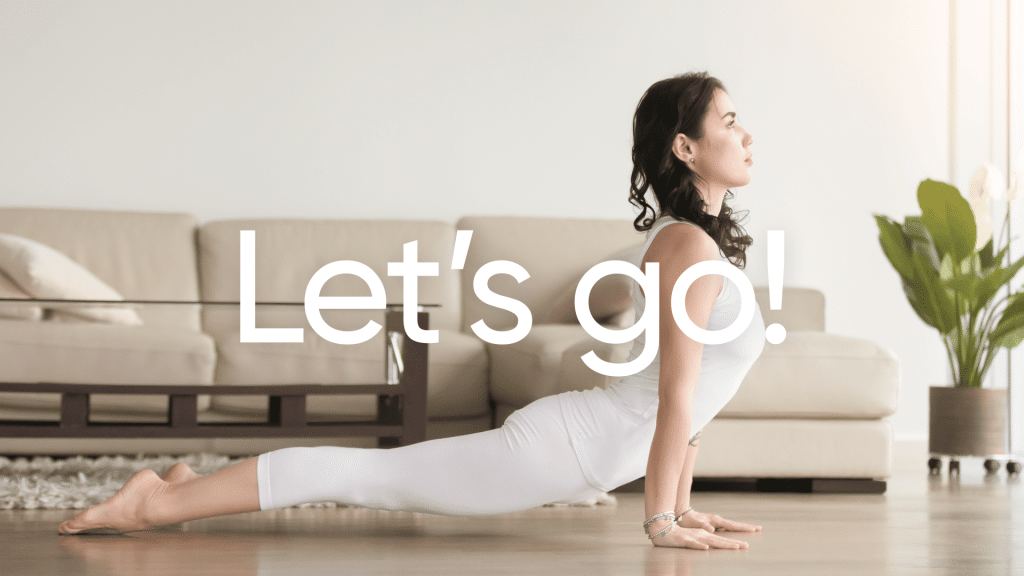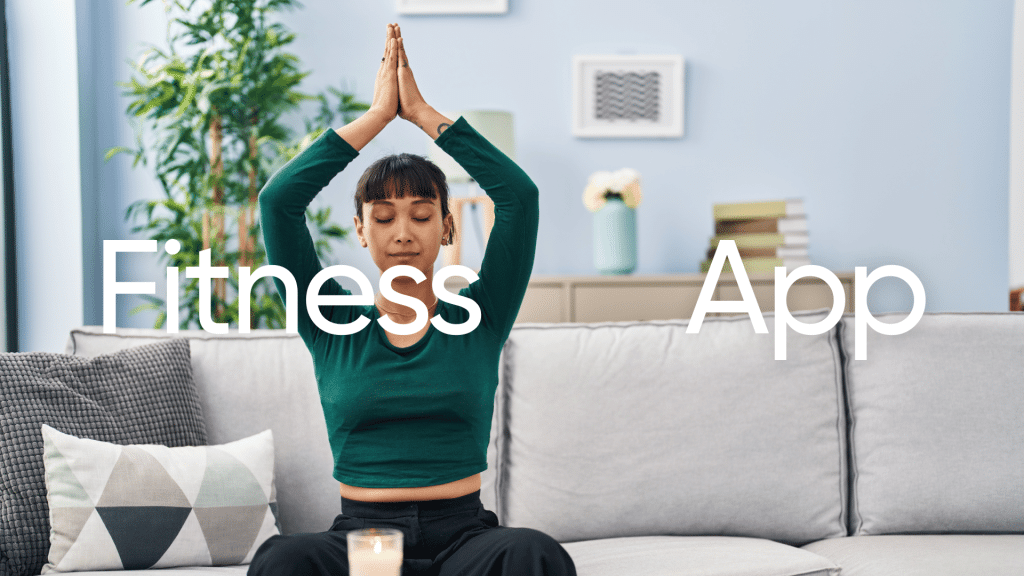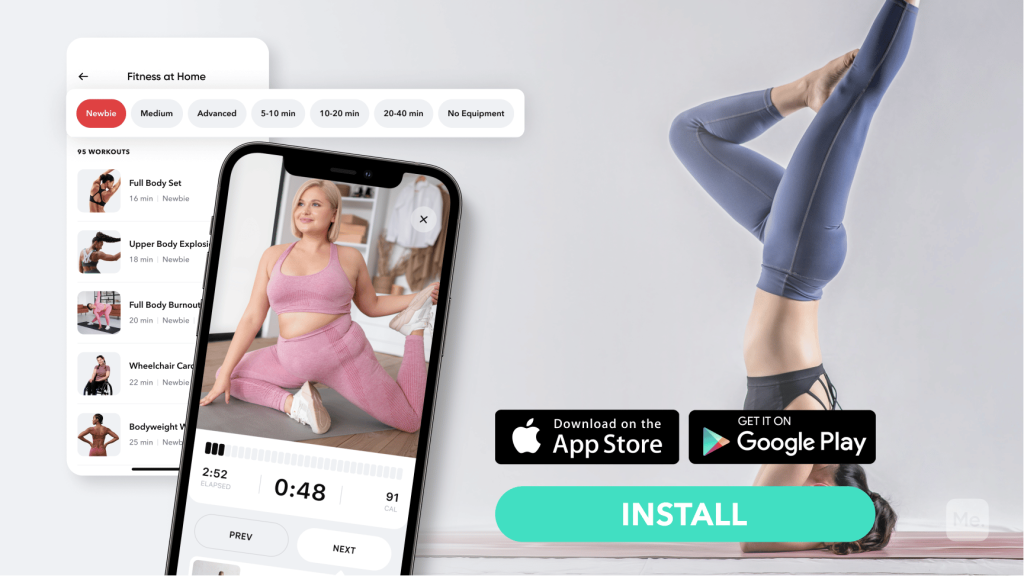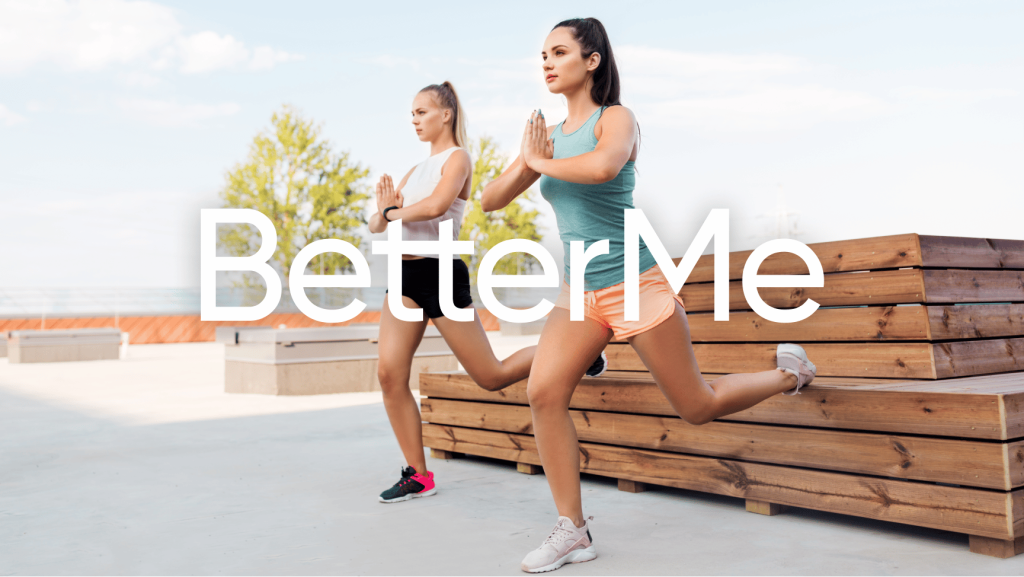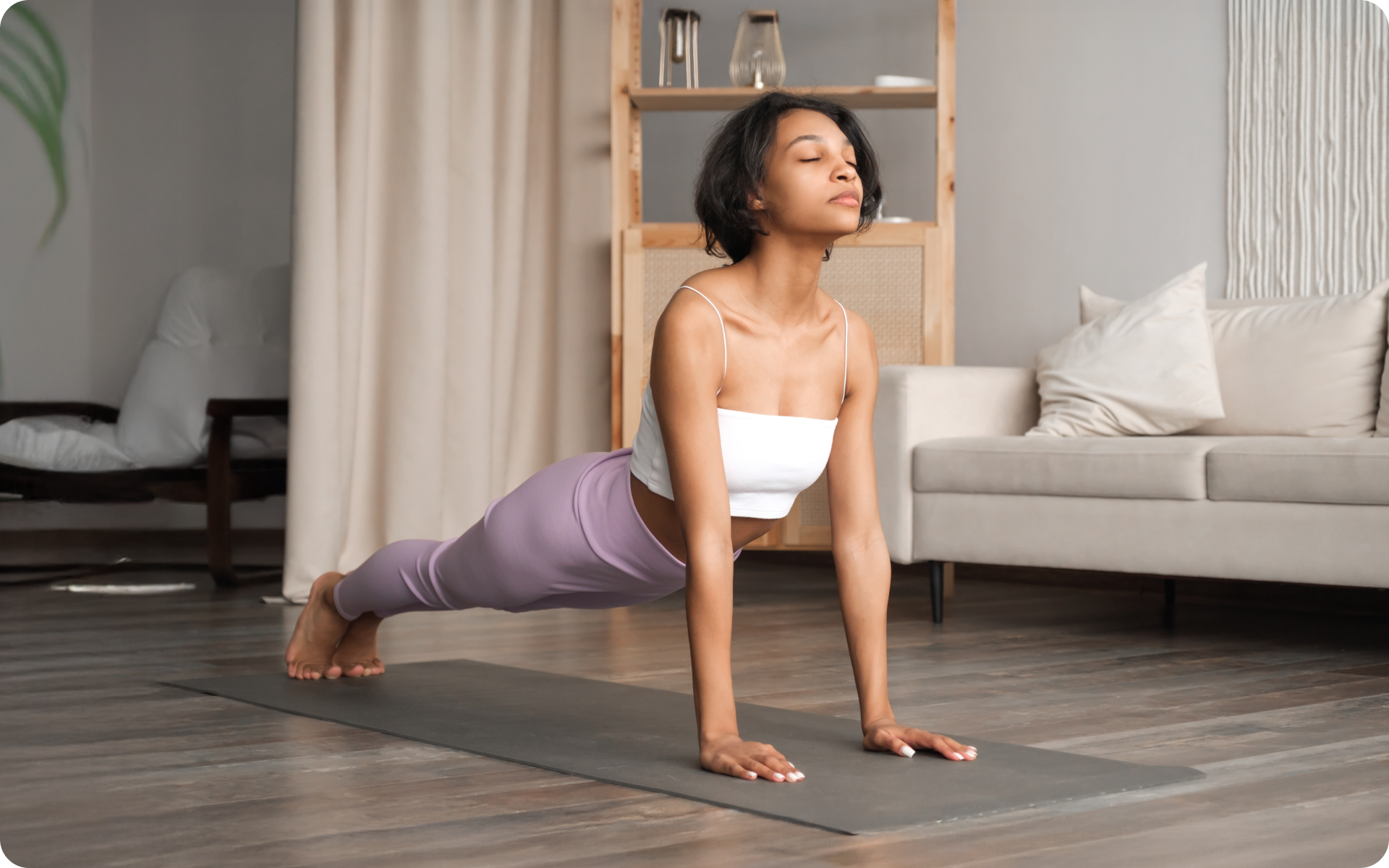Feeling a little too stiff for your own good? You’re not alone. Our lifestyles demand a lot from our bodies and, as a result, tightness and stiffness are all too common. This is especially true if you get less than 30 minutes of exercise each day or if you have a desk job that requires you to sit for long periods of time. Even when you’re fairly active, your body’s natural asymmetries (we all have them) can lead to tightness in certain areas. These refer to areas where your muscles, tendons, and ligaments are constantly being pulled in one direction only. Over time, this can lead to imbalances and, eventually, pain. The good news is that there are plenty of stretches you can do to loosen up your tight muscles and improve your flexibility. Dynamic stretching is one of the most effective methods for doing this. Here’s everything you need to know about dynamic stretching for the lower body, including a few of our favorite stretches.
Get your personalized
meal plan!
What Is Dynamic Stretching?
Dynamic stretching is a form of stretching that uses movement to lengthen muscles. This type of stretching is an active stretch, meaning that you are actively moving your body while stretching (14).
Dynamic stretches are different from static stretches, which involve holding a position for an extended period of time. Static stretches are typically done after a workout when your muscles are already warm and pliable (14).
Dynamic stretches, on the other hand, should be done before a workout. They help to warm up your muscles and prepare them for the upcoming activity.
There are some common lower-body issues that can be addressed with dynamic stretching. They include:
Poor Hip Mobility
Hip mobility refers to the ability of your hip joint to move through its full range of motion. Poor hip mobility is caused by tightness in the muscles and connective tissues around the hip joint (10).
This can lead to pain in the hips, knees, and lower back. Dynamic stretching can help improve hip mobility by lengthening the muscles and tissues around the joint (9).
Tight Or Weak Hamstrings
The hamstrings are a group of three muscles that run along the back of the thigh. They are responsible for bending the knee and extending the hip (1). When the hamstrings are tight or weak, this can lead to pain in the lower back, knees, and hips (3) (11).
You may notice that your stride is shorter when walking or running, and you may have difficulty touching your toes. Dynamic stretches can strengthen and activate the hamstrings, improving your range of motion and preventing pain (7).
Poor Ankle Mobility And Stability
The ankles are an important, yet often overlooked, part of the lower body. They provide stability when walking and running, and they allow for a full range of motion in the feet (5).
Poor ankle mobility and stability can lead to injuries, such as rolled ankles or Achilles tendonitis Wearing heels can also contribute to this problem. Dynamic stretches that target the ankles can help to improve mobility and stability, preventing pain and injury.
Read More: The 7 Different Types Of Stretching Exercises: How To Do Them And Their Benefits
Inactive Glutes
The glutes are a group of three muscles that make up the buttocks. These muscles are responsible for extending the hip and stabilizing the pelvis (12).
When the glutes are inactive or weak, this can lead to overcompensation from other muscles, such as the hamstrings and lower back. This can cause pain in the hips, knees, and lower back.
Dynamic stretches that target the glutes can help to activate and strengthen these muscles, improving your posture and preventing pain.
Inactive Adductors
Adductors are a lesser-known group of muscles that are located on the inside of the thigh. These muscles are responsible for bringing the legs together and stabilizing the pelvis (2).
When the adductors are weak or inactive, this can lead to overcompensation from other muscles, such as the glutes and lower back. This in turn can affect your posture and cause pain in the hips, knees, and lower back.
Dynamic stretches that target the adductors can help activate and strengthen these muscles, improving your posture and preventing pain.
Benefits Of Dynamic Stretches
Dynamic stretches are a great way to improve your flexibility and range of motion. They can also help improve your joint health and reduce your risk of injuries. Here are some benefits of dynamic stretches:
1. Improve Flexibility And Range Of Motion
You need to have good flexibility and range of motion to perform activities like running, swimming, and playing sports. Dynamic stretches help improve your flexibility and range of motion by lengthening your muscles and joints (15).
2. Improve Joint Health
Dynamic stretches can also help improve your joint health. When you stretch, you increase the space between your joints. This helps reduce the friction between your joints, which can lead to joint pain (17).
3. Reduce Your Risk Of Injuries
Dynamic stretches can help reduce your risk of injuries (18). When you stretch, you increase the range of motion in your joints and muscles. This helps them to move more freely and reduces your risk of strains and sprains.
4. Improve Your Posture
Poor posture can lead to back pain, neck pain, and headaches (13). By stretching your muscles, you can improve your posture and reduce your risk of these problems (8).
5. Increase Blood Flow To Your Muscles
Dynamic stretches can also help increase blood flow to your muscles. This helps oxygenate your muscles and improve your athletic performance (6).
Looking for a way to break the vicious cycle of weight loss and tone up all the jiggly parts? Watch the extra pounds fly off and your muscles firm up with the BetterMe app!
Who Needs Lower Body Dynamic Stretches?
Dynamic stretches are suitable for all levels of fitness. They can be particularly beneficial for those who are new to exercise, as they can help gradually increase range of motion and prevent injuries.
However, dynamic stretches can also be beneficial for experienced athletes who are looking to improve their performance.
When Should You Do Dynamic Stretches For The Lower Body?
Dynamic stretches can be done as a standalone workout or as part of a warm-up routine. Below are several scenarios where dynamic stretches can be beneficial:
- Before a strength training workout: Doing dynamic stretches before a workout can help to warm up your muscles and prepare them for the upcoming activity. This can help prevent injuries and improve performance.
- Before a run or race: Dynamic stretches can help increase blood flow to your muscles and improve range of motion. This can help you avoid injuries and perform your best.
- On active rest days: Dynamic stretches are a great way to stay active on days when you’re not working out. They can help to improve range of motion and flexibility, and they can also help prevent injuries.
How Often Should You Do Dynamic Stretches?
The frequency with which you do dynamic stretches will depend on your goals. For example, if you’re looking to improve your flexibility, you might want to do dynamic stretches every day.
Note that stretching to improve your flexibility must go hand-in-hand with some form of muscle-strengthening exercise to avoid overstretching and developing joint instability.
If you’re using dynamic stretching as part of your warm-up routine before exercise, you’ll only need to do it 2-3 times per week, or as often as you exercise.
Read More: Static Vs Dynamic Stretching: Understanding The Difference
What Are The Best Dynamic Stretches For The Lower Body?
Dynamic stretches for legs, glutes, and hips mimic common movements such as walking, lunging, and squatting. Below are some of the best dynamic stretches for lower body:
Lateral Lunge
This exercise develops hip mobility and increases the functional range of your hamstrings and glutes. To perform a lateral lunge:
- Start in an athletic stance with your feet shoulder-width apart and your hands on your hips.
- Take a large step to the right, keeping your feet in line with your hips.
- As you step, bend your right knee and shift your weight over your right leg.
- Keep your left leg straight as you lunge to the side.
- Return to the starting position and repeat on the other side.
Rotational Lunge
This exercise increases the functional range of motion of your obliques, abdominals, and hip flexors. It also targets the stabilizing muscles of your pelvis and low back. To perform a rotational lunge:
- Start in an athletic stance with your feet shoulder-width apart and your hands on your hips.
- Take a large step forward with your right leg, keep your feet in line with your hips.
- As you step, bend your right knee and rotate your torso to the right.
- Shift your weight over your right leg as you lunge forward.
- Return to the starting position and repeat on the other side.
Inchworm
Stretch your calves, hamstrings, and low back with this simple yet effective exercise. The inchworm also challenges your balance and coordination. To perform an inchworm:
- Start in a standing position with your feet shoulder-width apart.
- Bend forward at the hips and place your hands on the ground in front of you.
- Walk your hands forward until you are in a push-up position.
- Keeping your legs straight, walk your feet forward until they are in line with your hands.
- Reverse the movement and return to the starting position.
Alternating Toe Touch
This exercise develops the range of motion of your hamstrings, low back, and shoulders. It also challenges your balance and coordination. To perform an alternating toe touch:
- Start in a standing position with your feet shoulder-width apart.
- Raise your right leg and reach for your toes with your right hand.
- Return to the starting position and repeat with the left leg and left hand.
Lateral Leg Swings
This exercise increases the range of motion of your hips, hamstrings, and low back. To perform a lateral leg swing:
- Start by holding on to a support with your left hand.
- Swing your right leg out to the side and up as high as you can.
- Return to the starting position and repeat with the left leg.
Squat Jumps
Build explosive power (aka plyometrics) in your lower body with squat jumps. This exercise will also challenge your balance and coordination. To perform a squat jump:
- Start in an athletic stance with your feet shoulder-width apart and your hands on your hips.
- Bend your knees and lower your hips into a squatting position.
- Swing your arms behind you and jump as high as you can.
- Land softly on your feet and repeat.
High Knees
This exercise develops the range of motion of your hip flexors, quads, and calves. It also challenges your coordination. To perform high knees:
- Start by running in place, keeping your feet shoulder-width apart.
- As you run, bring your knees up toward your chest.
- Keep your feet in line with your hips and land softly on your toes.
- Continue running, keeping your knees up, for 30 seconds to 1 minute.
If you tend to let yourself off the hook, raise the white flag when things get tougher than you expected, send yourself on an unconscious binge-eating trip – BetterMe app is here to help you leave all of these sabotaging habits in the past!
Butt Kickers
This exercise develops the range of motion of your hamstrings. It also challenges your coordination. To perform butt kickers:
- Start by running in place, keeping your feet shoulder-width apart.
- As you run, kick your heels back toward your glutes.
- Keep your feet in line with your hips and land softly on your toes.
- Continue running, kicking your heels back, for 30 seconds to 1 minute.
How To Do Dynamic Stretches For Lower Body Effectively
At first glance, dynamic stretches for the lower body may look like regular stretches. However, there are a few key differences that you should be aware of. Take note of the following tips to ensure that you’re doing dynamic stretches correctly:
Decide Which Muscle To Target
The first step is to identify which muscle or group of muscles you want to target. This will help you choose the right dynamic stretch for your needs.
For example, if you want to improve your flexibility in your hamstrings, you might want to try a dynamic stretch that involves kicking your leg up towards your butt.
Use the activity you’re preparing for to determine which muscle groups you should focus on. For example, if you’re getting ready for a run, you’ll want to focus on stretches that target your legs, hips, and lower back.
If you want to squat more effectively, you’ll want to focus on stretches that target your hips, glutes, quads, and hamstrings.
You can also choose a muscle group based on which area of your performance you want to improve. Weight lifters, for example, may be struggling with lack of depth in their squats. In that case, they might want to focus on stretches for their hip flexors and quads.
Develop A Mind-Muscle Connection
One of the most important aspects of exercise and stretching is developing a mind-muscle connection (4). This means that you should focus on the muscle that you’re targeting as you stretch.
For example, if you’re doing a hamstring stretch, you should focus on contracting your hamstrings as you move.
This mind-muscle connection is important because it helps you to focus on the muscles that you’re trying to target. It also helps you to control your movement, which is essential for preventing injuries.
Control Your Movement
Dynamic stretches should be done in a controlled and deliberate manner. This means that you should move slowly and smoothly, without jerking or bouncing. Remember to breathe deeply as you stretch, and focus on relaxing your muscles.
Push Your Limits Gently
The whole idea behind dynamic stretching is to increase your flexibility by lengthening your muscles. However, you should only push your limits as far as is comfortable. If you feel any pain, stop the stretch immediately and back off.
It’s also important to remember that you shouldn’t force a stretch. If you can’t reach your target muscle group, don’t try to force it.
What might look like a failed attempt is actually a good thing- it means that you’re stretching within your limits and preventing injury. You’ll notice that with regular stretching, your range of motion will gradually increase.
Warm Up First
Muscles are more pliable when they are supplied with blood at a higher temperature (16). That’s why it’s important to warm up before you start stretching.
A light jog or other aerobic activity is a great way to increase blood flow to your muscles and prepare them for stretching. Spend 5-10 minutes warming up before you begin your dynamic stretches.
The Bottom Line
Dynamic stretches are an important part of any exercise routine. They help improve flexibility, prevent injuries, and increase your range of motion. When done correctly, dynamic stretches can help you perform at your best and reach your fitness goals.
DISCLAIMER:
This article is intended for general informational purposes only and does not serve to address individual circumstances. It is not a substitute for professional advice or help and should not be relied on for making any kind of decision-making. Any action taken as a direct or indirect result of the information in this article is entirely at your own risk and is your sole responsibility.
BetterMe, its content staff, and its medical advisors accept no responsibility for inaccuracies, errors, misstatements, inconsistencies, or omissions and specifically disclaim any liability, loss or risk, personal, professional or otherwise, which may be incurred as a consequence, directly or indirectly, of the use and/or application of any content.
You should always seek the advice of your physician or other qualified health provider with any questions you may have regarding a medical condition or your specific situation. Never disregard professional medical advice or delay seeking it because of BetterMe content. If you suspect or think you may have a medical emergency, call your doctor.
SOURCES:
- Anatomy, Bony Pelvis and Lower Limb, Hamstring Muscle (2022, ncbi.nlm.nih.gov)
- Anatomy, Bony Pelvis and Lower Limb, Medial Thigh Muscles (2022, ncbi.nlm.nih.gov)
- A novel approach to improve hamstring flexibility: A single-blinded randomised clinical trial (2019, ncbi.nlm.nih.gov)
- Attentional Focus for Maximizing Muscle Development: The Mind-Muscle Connection (2016, journals.lww.com)
- Biomechanics of the ankle (2016, ncbi.nlm.nih.gov)
- Daily muscle stretching enhances blood flow, endothelial function, capillarity, vascular volume and connectivity in aged skeletal muscle (2018, pubmed.ncbi.nlm.nih.gov)
- Dynamic Stretching Has Sustained Effects on Range of Motion and Passive Stiffness of the Hamstring Muscles (2019, ncbi.nlm.nih.gov)
- Effect of an exercise program for posture correction on musculoskeletal pain (2015, ncbi.nlm.nih.gov)
- Effects of Dynamic Stretching with Different Loads on Hip Joint Range of Motion in the Elderly (2019, ncbi.nlm.nih.gov)
- Hip Pain & Mobility Deficits (n.d., physio-pedia.com)
- Influence of Hamstring Tightness in Pelvic, Lumbar and Trunk Range of Motion in Low Back Pain and Asymptomatic Volunteers during Forward Bending (2015, ncbi.nlm.nih.gov)
- Muscles of the Gluteal Region (n.d., teachmeanatomy.info)
- Posture (n.d., physio-pedia.com)
- Stretching (n.d., physio-pedia.com)
- The effect of warm-up, static stretching and dynamic stretching on hamstring flexibility in previously injured subjects (2009, biomedcentral.com)
- The effect of warm-ups with stretching on the isokinetic moments of collegiate men (2018, ncbi.nlm.nih.gov)
- The relevance of stretch intensity and position—a systematic review (2015, frontiersin.org)
- To stretch or not to stretch: the role of stretching in injury prevention and performance (2010, onlinelibrary.wiley.com)


